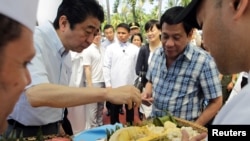Japanese Prime Minister Shinzo Abe’s visit to the Philippines this week shows U.S. ally Tokyo’s ambition to keep up with growing Chinese influence in the geopolitically strategic Southeast Asian country by ensuring steady flows of aid and investment, analysts say.
Abe traveled Thursday and Friday to Manila and Davao, the second-largest Philippine city and hometown of President Rodrigo Duterte. He’s the first head of state to visit Duterte since the Philippine president took office June 30.
Duterte is seeking stronger ties with Japan as well as China to form a multicountry foreign policy with declining reliance on the United States. For Japan, stronger relations will help it contain China, which has distrusted Tokyo since World War II. Tokyo and Beijing also dispute sovereignty over parts of the East China Sea.
“From a geopolitical standpoint, I think the interesting thing about the visit of Japan has do to with, at least from the Philippine standpoint, [that] this is all part of the independent foreign policy thrust that the Duterte administration has been talking about,” said Herman Kraft, political scientist at University of the Philippines Diliman.
Reminder of Japanese investment
Because the Philippines has laid out the red carpet to China and agreed to set aside the Beijing-Manila maritime dispute, Abe “probably thinks he should show face in Manila as a reminder that there’s plenty of Japanese investments,” said Song Seng Wun, an economist in the private banking unit of CIMB in Singapore.
Japan, the Philippines and the United States have been loosely allied since the Cold War in checking China’s expansion. But the sometimes crudely spoken 71-year-old Philippine leader has threatened to scrap military alliances as he distances his country from Washington, which he says has too much influence.
The United States was the Southeast Asian archipelago’s colonizer of nearly five decades through World War II. Before Duterte took office, U.S. ships were helping the Philippines keep alert for Chinese vessels in the disputed South China Sea.
Duterte visited China in October, winning a pledge of $24 billion in aid and investment from Beijing and agreeing to shelve disputes over control of the sea between them. Japan offered $1.8 billion in aid that month when Duterte visited Tokyo, and Japanese conglomerate Marubeni Corp. said it would spend $17.2 billion to improve Philippine highways, electrical power and mass transit.
Five deals struck
Japan was the largest source of Philippine direct foreign investment in 2015, with a total of $18 billion. That amount covers automotive factories, farming projects in remote areas and tourism facilities. Those investments give Japan a good name among Filipinos, who often worry about China because of the maritime dispute.
On Thursday, the two leaders met for 40 minutes and reached five deals, which cover Japanese help for agribusiness as well as a $5.2 million grant for Philippine coast guard speedboats and anti-terrorism equipment.
Japan already contributes heavily to the largely impoverished Philippines through the Manila-based Asian Development Bank, which has lent the Philippines an average $745 million per year since 2006 for poverty reduction.
“In the past years, Japan has really provided huge amounts of aid to the country in terms of poverty reduction, social protection, and also in terms of infrastructure that leads to more economic opportunities in the rural areas, so we are hopeful that this visit will move that forward,” said Georgina Hernandez, spokeswoman for Philippine Vice President Leni Robredo.
Maritime security
Abe and Duterte discussed maritime security this week, too, according to Philippine media reports. The Philippine military ranks 51st in the world, well behind China, which ranks third, behind the U.S. and Russia.
It has looked in the past to Japan for help, especially as China expands its military presence in the contested sea, sometimes sending vessels into waters that Manila claims. Last year, Japan gave the Philippines two patrol vessels and said it would lease training aircraft. It had offered an additional 10 coast guard ships to Duterte’s predecessor.
Japan has given military and development aid elsewhere in Southeast Asia to counter China’s influence at sea.
Unlike the United States, China and Japan avoid criticizing Duterte’s suspected 6,000 extrajudicial killings in a crackdown on illegal drugs. Abe instead pledged this week to help the effort through programs to treat drug users. Duterte said he welcomed the help.
Abe’s visit need not stop Duterte from keeping up relations with China, and he shows signs of courting it by shelving the maritime dispute as head of the 10-member Association of Southeast Asian Nations this year. China bristles when international organizations discuss its contested claim to about 95 percent of the sea.
Other countries, such as Indonesia and Vietnam, have reached out at the same time to China, Japan and the United States.
“It’s not unprecedented in the sense that you would find examples in places like in Southeast Asia,” said Rahul Bajoria, regional economist with Barclays in Singapore. “Singapore to an extent, India have had pretty decent success in terms of being able to attract investment from even contradictory sources, and so it really depends on how the [Philippine] government navigates this whole thing.”









